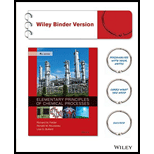
Concept explainers
(a)
Interpretation:
The total mass balance on the tank needs to be determined and it is to be proved that the total mass of the liquid in the tank remains the same.
Concept introduction:
Assume tank is perfectly mixed
Mass balance over tank =ṁ
= (volumetric inlet feed rate x Density of solution) -
(volumetric outlet feed rate x Density of solution)
(b)
INTERPRETATION:
The balance on sodium nitrate needs to be determined and converted into equation for
Concept introduction:
Sodium Nitrate is denoted by NaNO3.
By using derivation equation we will calculate the mass of fraction of NaNO3.
So, Considered, x(t,ṁ) equal to mass of fraction of NaNO3.
(c)
Interpretation:
The shapes of the plots gives mass rates needs to be sketched on a single graph of x versus t.
Concept introduction:
The graph will be first drawn for x vs t.
For x vs t graph
(d)
Interpretation:
The expression for
Concept introduction:
The graph will be first drawn for x vs t.
For x vs t graph
(e)
Interpretation:
The time taken to flush out 90%, 99% and 99.9% of the sodium nitrate needs to be calculated.
Concept introduction:
The following equation will be taken to find the equation for time calculation:
The derivation will produce:
(f)
Interpretation:
The shapes of the plots of x versus t expected with the impeller on and off that shows the difference between the two curves at small and large t values needs to be sketched on the same chart.
CONCEPT INTRODUCTION:
The graph will be first drawn for x vs t.
For x vs t graph
Want to see the full answer?
Check out a sample textbook solution
Chapter 10 Solutions
Elementary Principles of Chemical Processes, Binder Ready Version
 Introduction to Chemical Engineering Thermodynami...Chemical EngineeringISBN:9781259696527Author:J.M. Smith Termodinamica en ingenieria quimica, Hendrick C Van Ness, Michael Abbott, Mark SwihartPublisher:McGraw-Hill Education
Introduction to Chemical Engineering Thermodynami...Chemical EngineeringISBN:9781259696527Author:J.M. Smith Termodinamica en ingenieria quimica, Hendrick C Van Ness, Michael Abbott, Mark SwihartPublisher:McGraw-Hill Education Elementary Principles of Chemical Processes, Bind...Chemical EngineeringISBN:9781118431221Author:Richard M. Felder, Ronald W. Rousseau, Lisa G. BullardPublisher:WILEY
Elementary Principles of Chemical Processes, Bind...Chemical EngineeringISBN:9781118431221Author:Richard M. Felder, Ronald W. Rousseau, Lisa G. BullardPublisher:WILEY Elements of Chemical Reaction Engineering (5th Ed...Chemical EngineeringISBN:9780133887518Author:H. Scott FoglerPublisher:Prentice Hall
Elements of Chemical Reaction Engineering (5th Ed...Chemical EngineeringISBN:9780133887518Author:H. Scott FoglerPublisher:Prentice Hall
 Industrial Plastics: Theory and ApplicationsChemical EngineeringISBN:9781285061238Author:Lokensgard, ErikPublisher:Delmar Cengage Learning
Industrial Plastics: Theory and ApplicationsChemical EngineeringISBN:9781285061238Author:Lokensgard, ErikPublisher:Delmar Cengage Learning Unit Operations of Chemical EngineeringChemical EngineeringISBN:9780072848236Author:Warren McCabe, Julian C. Smith, Peter HarriottPublisher:McGraw-Hill Companies, The
Unit Operations of Chemical EngineeringChemical EngineeringISBN:9780072848236Author:Warren McCabe, Julian C. Smith, Peter HarriottPublisher:McGraw-Hill Companies, The





